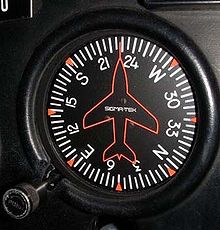Course top

The gyro is employed in aircraft gyroscope for direction measurement .
In contrast to that used on ships gyrocompass - with whom he is often confused - the gyro is not chained , but a free gyro . Its fully cardanically suspended axis is held by an erecting mechanism in a plane in which the longitudinal and transverse axes of the aircraft lie. The axis of the gyro always remains at right angles to the vertical axis of the aircraft. Its measuring principle is based on the directional stability of the rotor's axis of rotation. The greater the angular momentum of the gyroscope, the greater its moment of inertia and its rate of rotation , the better .
The gyro axis can be manually adjusted to the display of the magnetic compass. The gyro then shows the course in the horizontal plane of the earth. The angular scale of course gyroscopes is usually divided into 5 degrees, so reading is possible to an accuracy of about 1 to 2 degrees.
If the aircraft is tilted, the plane of the gyro axis is no longer parallel to the earth's horizon plane. This means that the displayed direction deviates from the actual direction of the aircraft's longitudinal axis. In a full circle, it leads the true direction twice and lags it twice. This error is the cardan error , it disappears again when the incline is ended.
In addition to this error, the course top can be subject to other errors. Even if the gyro axis maintains its direction, the earth rotates beneath it. At the pole that's 15 degrees per hour. At other geographical latitudes, this rate of rotation is reduced by the sine of the latitude. Especially at the equator, i.e. at zero latitude, the effect is therefore zero. So there is an apparent drift of the course top at this rate. This can, however, be countered by letting the top precess in opposite directions by an adjustable torque by the same amount. For this purpose, the course top has a latitude nut , which can be moved along the top axis by turning. This means that gyroscopes do not show this apparent drift if they are correctly set for the geographical latitude. Unkempt gyroscopes have to be readjusted periodically on the magnetic compass during flight.
Another independent drift is the transport drift . It is proportional to the east-west component of the speed and the tangent of the geographical latitude. It is identical to changing course when moving along a great circle.
As long as the gyro drift remains below the specifications, the course gyro is a reliable measuring instrument for air navigation and an important addition to the magnetic compass, despite its simple design . In contrast to this, it is free of its errors and has a calmer display, so that it is also suitable for self-control by an autopilot.
The manual adjustment to the magnetic compass is performed by an automatic system with the Gyrosyn -compass, which continuously tracks the course gyro.